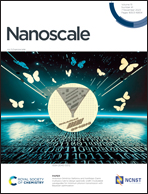A ligand strategy retarding monovalent copper oxidation toward achieving Cs3Cu2I5 perovskite emitters with enhanced stability for lighting†
Abstract
0D copper-based perovskites (Cs3Cu2I5) have fascinating optical properties, such as strong exciton binding energy, high photoluminescence quantum yield (PLQY) and large Stokes shifts from self-trapped excitons (STEs), which make them highly considerable candidates in the field of lighting. However, the stability of Cs3Cu2I5 is compromised by the oxidation of Cu+ to Cu2+ during the storage or operation process. Here, we proposed a ligand engineering strategy to improve the stability of Cs3Cu2I5via an organic molecule (ethylenediaminetetraacetic acid, EDTA) with multiple functional groups. The strong interaction between carboxyl groups and Cu+ was evidenced through FTIR and XPS, and it could retard monovalent copper oxidation. After storing for 90 days, the EDTA-engineered Cs3Cu2I5 (EDTA–Cs3Cu2I5) maintained its original crystalline structure, while the control Cs3Cu2I5 exhibited an impurity phase. Through quantitative analysis, the content of Cu2+ in EDTA–Cs3Cu2I5 was found to be 83.9% lower than that in control Cs3Cu2I5. Benefiting from the inhibition of Cu+ oxidation, EDTA–Cs3Cu2I5 exhibited improved light emission stability. For example, the optimized EDTA–Cs3Cu2I5 retained 74.7% of the initial photoluminescence (PL) intensity after 90-day storage under ambient conditions, while the pure Cs3Cu2I5 retained only 41.7%. Furthermore, EDTA could passivate defects and enhance the PL properties of the optimized Cs3Cu2I5, which showed a PLQY of 94.7%, much higher than that of 71.4% for pure Cs3Cu2I5. We further constructed a WLED based on the EDTA-engineered Cs3Cu2I5, which showed CIE at (0.3238, 0.3354), a CRI of 91.7, and a T50 of 361 h. The proposed EDTA ligand strategy provides a new way to regulate the light-emitting properties and stabilities of Cs3Cu2I5 for future industrialization.



 Please wait while we load your content...
Please wait while we load your content...